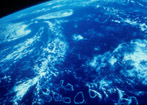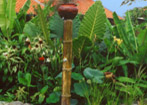|
Tahiti,
French Polynesia
6th
– 16th June 2004
In the city of Papeete, the French influence on
Polynesia is exaggerated. Supermarket
shelves are laden with foie gras, bouillabasse and row upon row of fine
fromages. Unfortunately, only
the baguettes are affordable, their prices being standardized by
government. Most other items
are astronomically expensive as are most aspects of life in French
Polynesia.
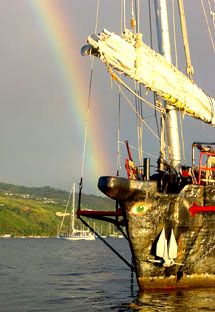
The Heraclitus anchored in Papeete
The central plaza in the harbour attracts a gathering
in the evenings, centred around the roulottes (restaurant-vans) selling
steak-frîtes and crêpes. Here we could
observe the cultural mix that makes up French Polynesia today – the
Polynesians with European blood in varying degrees, the Chinese and, of
course, the French. Oceania
and Europe have merged here intractably.
Polynesian femininity is displayed by most women wearing a flower
behind their ear. And the
French influence is encapsulated in the double-kiss, the standard greeting
today all over French Polynesia for the ex-pat French and the islanders
themselves.
Our ten day stop here was action-packed as we tried
to cram in as many tasks as possible, including everybody having a few
days to explore the island thoroughly.
The peaks beckoned to some who climbed to the clouds to look back
down onto Moorea, lying quietly across the Sea of the Moon.
The waterfalls called to others in search of the perfect Polynesian
scene complete with vahines bathing in the crystal flows. And yet others drove to the ‘end of the road’ at Taitura
where the road comes to a sudden halt and only a track through the bush
continues.

one of Tahiti's many waterfalls
We arrived in Tahiti at the right time –
preparations were in full swing for the heiva, the cultural
festival that happens all over French Polynesia every July, centred around
Bastille Day (14th July).
Singers, dancers, canoeists, stone-lifters have been in training
for at least four hours every day for four months for this festivity.
The heiva alternates each year between being a showcase for culture
and a competition between groups – this year is a competition and the
intensity in rehearsals reveals the drive among this new generation of
Polynesians to return to the essence of their cultural roots.
Until only recently, the Tahitian language was even forbidden in
schools. But there is a
cultural reversal occurring right now – this current generation are
eager to gather knowledge from their grandfathers, knowing that their own
fathers have inherited nothing. And
the visible evidence of this is in the dancing we saw at Tautira - one
hundred and twenty girls and boys gathered in a dance illustrating a local
legend, accompanied by an orchestra of thirty drummers, their hips shaking
faster than the eye can follow, their legs stomping and their faces filled
with a sense of identity. This
was just a rehearsal.
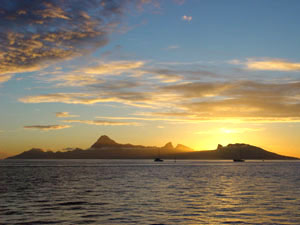
the view across to Moorea
The culture of the islands
is very well represented in the Musee des Iles on Tahiti. Displays of tools and art from the Societies, the Tuamotus
and the Marquesas illustrate the narrow band of materials with which they
had to work and the creativity and attention to detail that they employed
in their productivity. Seashells
were carved using the washed-up skeletons of the corals Porites and
Acropora to make sharp fish hooks.
Daggers were made from wood, bone, sharks’ teeth and the tails of
sting rays. Cloths (tapa)
were made from the barks of the mulberry, breadfruit and banyan trees. Ornamental necklaces were made from dolphin and human teeth,
braided onto human hair. Their
weaving was delicate and intricate, especially in the Marquesas.
The pandanus baskets used today by most dawn-shoppers at the fresh
food market look positively clumsy in comparison.
The lower slopes on Tahiti
Iti (little Tahiti, the island connected by a sizeable land bridge to
Tahiti Nui, the main island) are smothered in plantations – pineapple,
banana, papaya, cabbage, lettuce, cucumber, sweet potato, ginger,
grapefruit, lemon, lime, bamboo, taro, sweet potato.
Herds of silk-coated cattle roam grassy fields.
These islands are incredibly fertile, their dark volcanic soil
providing food for many. And
for us they provided a perfect vantage point to see geology in action –
a bird’s eye view of the barrier reef ringing the island.
We mingled with tall ships
and superyachts in Taina Marina on our morning of departure, fuelling up
and making final supply runs in the supermarket.
We made our way out of the channel, and spent the night drifting in
the Sea of the Moon, on our way to Huahine.
Tahiti has not lost its magic since Herman Melville, Robert Louis
Stevenson and Paul Gauguin were drawn here.
Huahine,
French Polynesia
18th
– 24th June 2004
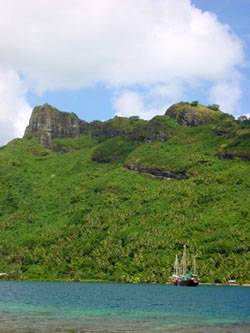
The
ship at anchorage inside Cook's Bay or Haavai Bay
Huahine was quiet compared to the bustle of Tahiti.
We took gentle strolls and bike rides around the island, learning
recipes for chicken/split-pea soup. We
met canoe teams in training for the races during heiva.
We were made gifts of fresh vanilla pods before they were shipped
back to Papeete.
The island is proud of one of its marae sites.
The maraes were the places of worship in the old Polynesian
culture, different maraes representing different purposes.
For example, a marae could be for a specific clan or tribe, or just
for a family, or for the fishermen, the canoe builders, the healers.
The major marae site in Huahine is a large area on the edge
of an inlet with many ‘altars’. But
the more enchanting maraes were those found haphazardly, on a stroll
through the bush.
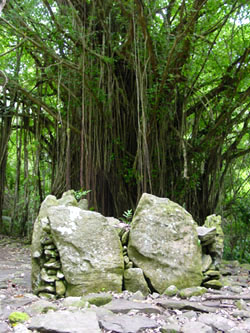
We dived in the channel that leads back out from the
lagoon to the open ocean. The
reef here on the outer slopes of Huahine’s western barrier reef is
spectacular with corals competing fiercely with each other for space,
barely an inch of substrate to spare.
The fish life was equally lively, although behaviours were
definitely altered by the shark-feeding that has and still does go on in
the pass to attract tourists. This
is the most invigorating reef we have seen in French Polynesia so far.
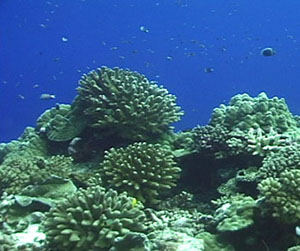
a view of the reef flat in Huahine
Huahine Dive Log
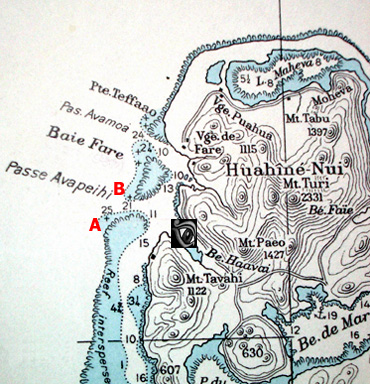
| Date: June 19th |
TI: 1330 |
TO: 1415 |
MaxDepth: 24m |
| Divers:
Eibes, Carol, Orla |

We dived on the south side of Avapehi Pass - a soft slope down to
about 30m all along this reef, which flattened off to a mostly
rubble/sand bottom. The slope itself was completely smothered in
thriving hard corals - competing fiercely for space, overgrowing each
other with more than 90% hard coral coverage nearly all the way along
the slope. There was a south going current which we swam against,
ascending almost at the mouth of the pass.
The only large fish were a jack below us when we descended and
several sizeable peacock groupers on the slope. All other fish (and
there were plenty of them) were small reef fish, dense schools in places
- surgeonfish, anthias, triggerfish, wrasses. There were not many
parrotfish. A beautiful flame hawkfish (Neocirrihites armatus)
sat on a Pocillopora coral. The coral diversity was higher than
the Tuamotus although still dominated by Pocillopora, Acropora
and Porites..
| Date: June 20th |
TI: 1000 |
TO: 1100 |
MaxDepth: 28m |
| Divers:
Michel, Orla, Ben |
| Date: June 24th |
TI: 0700 |
TO: 0740 |
MaxDepth: 40m |
| Divers:
Michel, Eibes, Carol, Ben |
We first dropped in where we had dived before to see if we could run
into the pass with the current but the tide was just turning and the
current was starting to go out. The landscape looked very much like it
had before and the fish life was still composed of majority small reef
fish.
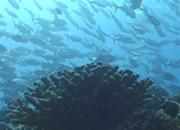
We ascended to drop down a second time on the other side of the
channel - this time, although the current was especially strong at
certain points, we maintained our position hovering up and down the
ledge. There was a school of giant barracuda on the corner as we
descended. An enormous school of big eye trevally hung pretty close to
the ledge, moving around the shelf. We passed them at first then
returned to become ensconced in their school, moving with them against
the current and surge to find where they were all going, only when we
got there they all left!
Fish behaviour here is a little unorthodox - there are chevron
butterflyfish which one would normally find glued to within a few inches
of a coral head out in the blue following divers. Black triggerfish
approach to masks very curiously. We know that there are shark-feeding
dives in the pass just to the north of here at Avamoa Pass. But it
appears that there have been strong human impacts on fish behaviour here
also.
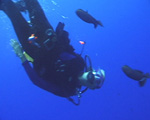
On our second dive here, we dropped down at the mouth of the pass in
the blue to be greeted by an eagle ray. As we continued down, at about
30m, we could just make out the passage of about 30 eagle rays. Then a
school of batfish swam by. The tide was almost slack, still running out
with a layer of silt coming out from the lagoon.
We met a couple of grey reef sharks then further up the pass, a baby
grey reef shark. There were many fish - red snappers, a school of giant
barracuda above us and a big school of smaller barracuda. As we entered
the pass, we followed the reef edge and again in the cut encountered a
big grey reef shark. Coming up to the reef crest, two turtles took
flight into the deep. Then a whitetip reef shark swam against snappers,
pufferfish and many damselfish, frantically flapping very high above the
corals.
A giant school of big eye trevally arrived while a school of blue
jacks passed by. Another couple of grey reef sharks made some passes
then we finished the dive in the shallows with a gorgeous reef - parts
of it dead from a previous disaster but still very healthy with large
amounts of Acropora growth. This dive site was a highlight in
our French Polynesia expedition.
|



